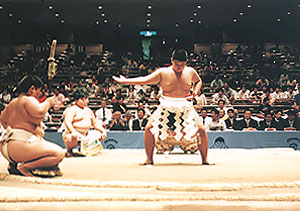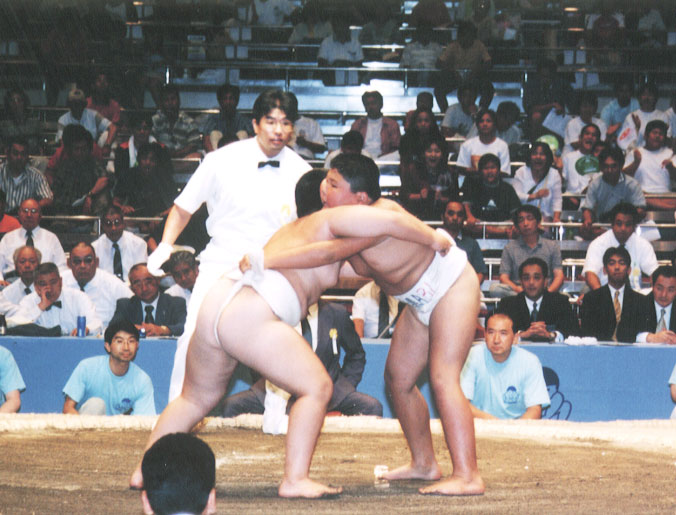|
 Yes! I can go to the All-Japan Tournament!" exclaimed fifth-grader Toshitaka Hoshino when he found out he had been picked to participate in the 17th Annual All-Japan Wanpaku Sumo Tournament for kids. Toshitaka was one of about 450 kids from 149 teams, selected from among 60,000 wanpaku rikishi (young sumo wrestlers) in all of Japan, who competed in this tournament at the Ryogoku Kokugikan in Tokyo, Japan's most famous sumo wrestling arena, on July 29.
Yes! I can go to the All-Japan Tournament!" exclaimed fifth-grader Toshitaka Hoshino when he found out he had been picked to participate in the 17th Annual All-Japan Wanpaku Sumo Tournament for kids. Toshitaka was one of about 450 kids from 149 teams, selected from among 60,000 wanpaku rikishi (young sumo wrestlers) in all of Japan, who competed in this tournament at the Ryogoku Kokugikan in Tokyo, Japan's most famous sumo wrestling arena, on July 29.
The Nihon Sumo Kyokai, sumo's governing body, and the Tokyo branch of the Japan Junior Chamber Incorporated have sponsored the All-Japan Wanpaku Sumo tournament since 1985 (wanpaku literally means "naughty child"). Each of the 60,000 young rikishi belongs to one of 229 local teams that entered through local branches of the JCI. When these kids go to local and national tournaments they aren't just competing for themselves. As Toshitaka says, "I have to do my best to represent everybody on my team and in my hometown." Girls and boys, from first-graders to sixth-graders, can take part in youth sumo, but the all-Japan tournament is only for fourth, fifth, and sixth-grade boys.
 Sumo has a long tradition and is said to have first begun as a test of skill and strength between two gods. Apart from this legend, the first recorded book of sumo by humans was over 1300 years ago, as a performance for the emperor. Today sumo holds the status of Japan's national sports. These young sumo wrestlers are proudly continuing that tradition. Today sumo holds the status of Japan's national sport. Recently it has also been gaining popularity internationally.
Sumo has a long tradition and is said to have first begun as a test of skill and strength between two gods. Apart from this legend, the first recorded book of sumo by humans was over 1300 years ago, as a performance for the emperor. Today sumo holds the status of Japan's national sports. These young sumo wrestlers are proudly continuing that tradition. Today sumo holds the status of Japan's national sport. Recently it has also been gaining popularity internationally.
The loser in sumo is the first one to leave the dohyo (ring) or touch the ground with anything but their feet. While the rules are simple, the techniques are not, and it takes a lot of practice to become a professional wrestler.
 Toshitaka had practiced long and hard, and this tournament was the big moment he had been waiting for. He and his opponent stepped into the ring and stood before the gyoji (referee). "Hakkeyoi!" (Ready!), shouted the referee, then "Nokotta!" (Go!), and the match began. The bout didn't last long. "Before I knew it, I had won!" said a triumphant Toshitaka.
Toshitaka had practiced long and hard, and this tournament was the big moment he had been waiting for. He and his opponent stepped into the ring and stood before the gyoji (referee). "Hakkeyoi!" (Ready!), shouted the referee, then "Nokotta!" (Go!), and the match began. The bout didn't last long. "Before I knew it, I had won!" said a triumphant Toshitaka.
Toshitaka lost a bout after that and didn't win the tournament this year, but says he'll be back to try again: "I'm going to practice hard, and next year I'll give it my best shot!"
The winners of the 2001 All-Japan Wanpaku Sumo Tournament, who now become yokozuna, were sixth-grader Hirofumi Nishiyama from Tokyo, fifth-grader Ren Nogami from Aomori Prefecture, and fourth-grader Shota Minami from Chiba Prefecture.
Photos: Tokyo Junior Chamber Inc.
|

 Yes! I can go to the All-Japan Tournament!" exclaimed fifth-grader Toshitaka Hoshino when he found out he had been picked to participate in the 17th Annual All-Japan Wanpaku Sumo Tournament for kids. Toshitaka was one of about 450 kids from 149 teams, selected from among 60,000 wanpaku rikishi (young sumo wrestlers) in all of Japan, who competed in this tournament at the Ryogoku Kokugikan in Tokyo, Japan's most famous sumo wrestling arena, on July 29.
Yes! I can go to the All-Japan Tournament!" exclaimed fifth-grader Toshitaka Hoshino when he found out he had been picked to participate in the 17th Annual All-Japan Wanpaku Sumo Tournament for kids. Toshitaka was one of about 450 kids from 149 teams, selected from among 60,000 wanpaku rikishi (young sumo wrestlers) in all of Japan, who competed in this tournament at the Ryogoku Kokugikan in Tokyo, Japan's most famous sumo wrestling arena, on July 29.
 Toshitaka had practiced long and hard, and this tournament was the big moment he had been waiting for. He and his opponent stepped into the ring and stood before the
Toshitaka had practiced long and hard, and this tournament was the big moment he had been waiting for. He and his opponent stepped into the ring and stood before the